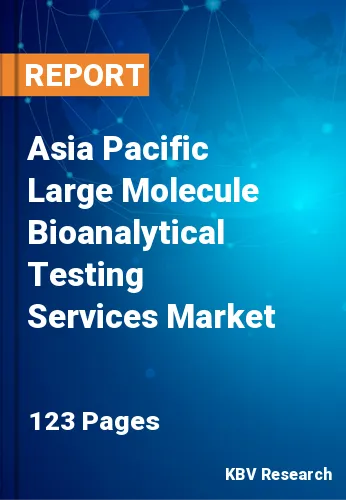The Asia Pacific Large Molecule Bioanalytical Testing Services Market would witness market growth of 10.1% CAGR during the forecast period (2022-2028).
For the aim of studying pharmacokinetics and pharmacodynamics, bioanalytical testing enables a quantitative measurement of the active medicines and their metabolites in biological systems. It is carried out throughout the drug development value chain and is essential for lead optimization and advancing a therapeutic candidate. Pharmaceutical companies carry out in-house bioanalytical testing throughout the drug discovery and lead optimization stages, while outsourcing is used for longer-term toxicity and Phase II investigations.
It is generally accepted that a bioanalytical method must first be validated to show that it is appropriate for its intended purpose before being put into normal usage. For all development investigations, a GLP (Good Laboratory Practices) certified bioanalytical method is required (e.g., toxicology studies and human clinical trials). There is widespread agreement that at least the following validation parameters should be assessed for quantitative procedures, per the Food and Drug Administration (FDA) GLP guidance selectivity, calibration model, stability, accuracy (bias, precision), and limit of quantification. Limit of detection (LOD), recovery, repeatability, and ruggedness are additional variables that may need to be assessed (robustness).
The cancers of the lung (19.2%), liver (10.5%), and stomach (9.9%) were the most common causes of death due to cancer. The region faces a carried a substantial burden of cancer, both in terms of the incidence & mortality rates of cancer. Cancer deaths were on the decline, but the disease is still becoming more prevalent overall, particularly among females and people of younger ages. The increasing emphasis placed by governments throughout the world on preventing the spread of infectious diseases is making a substantial contribution to the expansion of the market for large molecule bioanalytical testing services.
The China market dominated the Asia Pacific Large Molecule Bioanalytical Testing Services Market by Country in 2021, and would continue to be a dominant market till 2028; thereby, achieving a market value of $192.7 million by 2028. The Japan market is registering a CAGR of 9.4% during (2022 - 2028). Additionally, The India market would showcase a CAGR of 10.7% during (2022 - 2028).
Based on End-user, the market is segmented into SMEs and Large Firms. Based on Test Type, the market is segmented into Bioavailability, ADME, PD, Bioequivalence, and Others. Based on Type, the market is segmented into ADA, Pharmacokinetics, and Others. Based on Phase, the market is segmented into Clinical and Pre-clinical (With Antibody and Without Antibody (ELISA Based Assay)). Based on Therapeutic Areas, the market is segmented into Oncology, Neurology, Infectious Diseases, Cardiology, and Others. Based on countries, the market is segmented into China, Japan, India, South Korea, Singapore, Malaysia, and Rest of Asia Pacific.
Free Valuable Insights: The Worldwide Large Molecule Bioanalytical Testing Services Market is Projected to reach USD 2.8 Billion by 2028, at a CAGR of 9.1%
The market research report covers the analysis of key stake holders of the market. Key companies profiled in the report include Laboratory Corporation Of America Holdings, IQVIA Holdings, Inc., Syneos Health, Inc., SGS S.A., Intertek Group PLC, Pace Analytical Services, LLC, ICON Plc, Charles River Laboratories International, Inc., and Thermo Fisher Scientific, Inc.
By End-user
By Test Type
By Type
By Phase
By Therapeutic Areas
By Country
Our team of dedicated experts can provide you with attractive expansion opportunities for your business.

